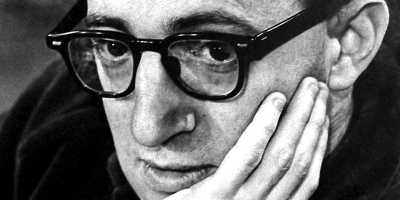 Jerry Kupcinet - photographer, CC BY-SA 3.0, via Wikimedia Commons
Jerry Kupcinet - photographer, CC BY-SA 3.0, via Wikimedia Commons
Manhattan
This article is part from The 10 best Woody Allen films
Table of contents
- Annie Hall
- Manhattan
- Hannah and Her Sisters
- Crimes and Misdemeanors
- Match Point
- Midnight in Paris
- Love and Death
- Bullets Over Broadway
- The Purple Rose of Cairo
- Zelig
10 curiosities and facts
-
The opening montage was originally supposed to be set to Gershwin's "Rhapsody in Blue"
However Allen ultimately decided to use George Gershwin's "Manhattan" as the soundtrack for the opening montage instead.
-
The movie was shot in black and white
Allen wanted the film to be shot in black and white to capture the essence of New York City and give the film a timeless quality. He felt that shooting it in color would have made it look too modern and distract from the story.
-
The movie was filmed in 1979, but not released until 1980
The film was completed in 1979, but Allen decided to delay its release until 1980 because he felt that it would perform better at the box office during the summer months.
-
The film was a critical and commercial success
"Manhattan" was both a critical and commercial success, grossing over $39 million worldwide and receiving two Academy Award nominations.
-
Woody Allen and Diane Keaton had previously worked together on "Annie Hall"
"Manhattan" marked the second time that Allen and Keaton had worked together following their collaboration on "Annie Hall" in 1977.
-
The famous scene on the Queensboro Bridge was shot without permits
The iconic scene in which Allen and Keaton stand on the Queensboro Bridge and look out over the Manhattan skyline was shot without permits. Allen and his crew quickly set up the shot and filmed it before anyone could stop them.
-
The film's themes of infidelity and age-gap relationships were controversial
The film's exploration of infidelity and age-gap relationships was controversial at the time of its release, with some critics accusing Allen of promoting immoral behavior.
-
The film's cinematographer was Gordon Willis
Gordon Willis, who also worked on "The Godfather" and "Annie Hall " was the cinematographer for "Manhattan." He helped create the film's distinct black and white aesthetic and worked closely with Allen to capture the essence of New York City.
-
Woody Allen wrote and directed the film
Allen not only directed "Manhattan, " but he also wrote the screenplay for the film. He drew inspiration from his own experiences living in New York City and his own personal relationships.
-
The film's title is a reference to the song "Manhattan" by Richard Rodgers and Lorenz Hart
The title of the film is a nod to the Rodgers and Hart song "Manhattan " which is featured prominently in the film's soundtrack. The song's lyrics are also a recurring motif throughout the film.
About the movie
"Manhattan" is perhaps Allen's most visually stunning film shot in gorgeous black and white by cinematographer Gordon Willis. The film follows a writer named Isaac Davis (played by Allen) as he navigates relationships with several women, including a teenage girl (Mariel Hemingway) and his best friend's mistress (Diane Keaton). The film's iconic opening sequence set to George Gershwin's "Rhapsody in Blue, " perfectly captures the energy and romance of New York City.
Shot in black and white and set against the backdrop of New York City, "Manhattan" is one of the most visually stunning films I've ever seen. One of my favorite scenes in the movie is when Isaac and Mary (Keaton's character) are walking through Central Park and discussing their relationship. The music, the cinematography and the dialogue all come together in a perfect moment that captures the bittersweet essence of the film.
What I find fascinating about "Manhattan" is the way it presents a romanticized version of New York City: despite the city's flaws and contradictions Allen portrays it as a beautiful and vibrant place that is full of life and energy. It's a love letter to a city that he clearly has a deep connection with, and that love comes through in every frame.
At the time the film almost didn't get made due to creative differences between Allen and the studio. They wanted him to shoot it in color but he insisted on black and white. In the end he got his way and the result is a stunning masterpiece that has stood the test of time.
When "Manhattan" premiered in 1979, it received mixed reviews from critics. Some praised it for its visual beauty and romanticism while others criticized it for being self-indulgent and elitist. But for me the film is a work of art that captures a moment in time and a place in history that will always be remembered as a golden age of cinema.
"Manhattan" is a must-see for anyone who loves movies, New York City or just great storytelling. It's a film that will make you laugh cry, and fall in love with the magic of the movies all over again.
Film sheet
- Director: Woody Allen
- Year: 1979
- Cast: Woody Allen Diane Keaton, Michael Murphy, Mariel Hemingway Meryl Streep
- Awards: BAFTA Awards (Best Film Best Director, Best Screenplay), Cannes Film Festival (Best Film) David di Donatello Awards (Best Foreign Director)
Film Reviews
- "A fantastic stylized, and honest movie about the American neurosis." - Pauline Kael The New Yorker
- "A masterpiece perhaps the finest film of the year." - Vincent Canby, The New York Times
- "Woody Allen's talent as a filmmaker is beyond dispute." - Roger Ebert Chicago Sun-Times
- "A film that must be seen." - Gene Siskel, Chicago Tribune